National Monument
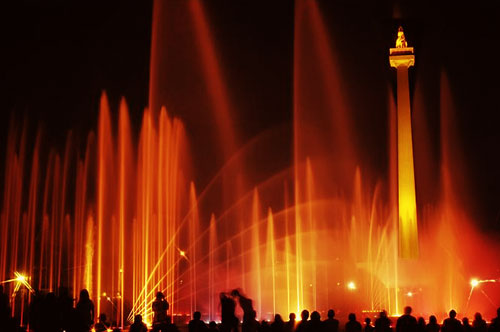 The National Monument, or "Monas" as it is popularly called, is
one of the monuments built during the Sukarno era of fierce nationalism.
The top of the National Monument (Monas) is Freedom Square. It stands
for the people's determination to achieve freedom and the crowning of
their efforts in the Proclamation of Independence in August 1945. The
137-meter tall marble obelisk is topped with a flame coated with 35 kg
of gold. The base houses a historical museum and a hall for meditations.
The monument is open to the public and upon request the lift can carry
visitors to the top, which offers a bird's eye view on the city and the
sea.
The National Monument, or "Monas" as it is popularly called, is
one of the monuments built during the Sukarno era of fierce nationalism.
The top of the National Monument (Monas) is Freedom Square. It stands
for the people's determination to achieve freedom and the crowning of
their efforts in the Proclamation of Independence in August 1945. The
137-meter tall marble obelisk is topped with a flame coated with 35 kg
of gold. The base houses a historical museum and a hall for meditations.
The monument is open to the public and upon request the lift can carry
visitors to the top, which offers a bird's eye view on the city and the
sea.Go early to beat the crowds and the haze. It is easy for the less physically able as lifts take visitors to the top. The diorama exhibition in the basement gives such a distorted view of Indonesian history - thanks to the dictator Suharto wanting to brainwash the nation - it's amusing. This imposing obelisk is Jakarta's most famous landmark. Construction started in 1961 under President Soekarno but was not completed until 1975, under President Soeharto. The monument houses a couple of museums. The Freedom Hall depicts Indonesia's struggle for independence through a series of dioramas, whereas the Hall of Contemplation displays the original Declaration of Independence document and a recording of the speech. An elevator takes one to the observation platform, which commands a bird's-eye view of the cityscape.
Beautiful Indonesia in Miniature Park (TMII)
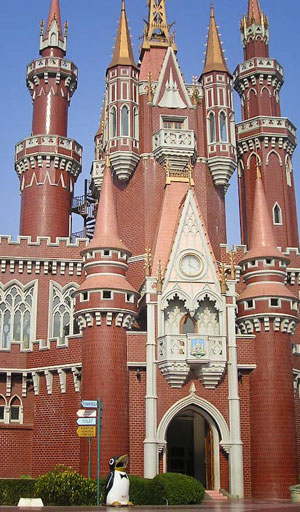 Taman Mini Indonesia Indah (Beautiful Indonesia in Miniature
Park) is Indonesia's answer to every visitor's prayer to see the
magnificent archipelago in just one day. An extensive park to get a
glimpse of the diverseness of the Indonesian archipelago, it represents
Indonesia's 27 provinces and their outstanding characteristics,
reflected most strikingly in the exact regional architecture of the
province. An extensive theme park set in over 100 hectares on the
outskirts of Jakarta; the All Indonesian islands are realistically
reproduced in miniature in a central lake and around the lakes, there
are pavilions. Each pavilions is representative of each province firm
the traditional architectural style in miniature to a wonderful display
of cultural items and exhibits. The park's centerpiece is a beautiful
artificial lake. The complex was the brainchild of Madam Tien Soeharto,
the late Indonesian first lady.
Taman Mini Indonesia Indah (Beautiful Indonesia in Miniature
Park) is Indonesia's answer to every visitor's prayer to see the
magnificent archipelago in just one day. An extensive park to get a
glimpse of the diverseness of the Indonesian archipelago, it represents
Indonesia's 27 provinces and their outstanding characteristics,
reflected most strikingly in the exact regional architecture of the
province. An extensive theme park set in over 100 hectares on the
outskirts of Jakarta; the All Indonesian islands are realistically
reproduced in miniature in a central lake and around the lakes, there
are pavilions. Each pavilions is representative of each province firm
the traditional architectural style in miniature to a wonderful display
of cultural items and exhibits. The park's centerpiece is a beautiful
artificial lake. The complex was the brainchild of Madam Tien Soeharto,
the late Indonesian first lady.It also has its own orchid garden in which hundreds of Indonesian orchid varieties are grown. There is also a bird park with a walk-in aviary, a fauna museum and recreational grounds with a swimming pool and restaurants. The special interest here at Taman Mini is the Museum Indonesia. A richly decorated building in Balinese architecture, it houses contemporary arts, crafts and traditional costumes from the different regions of the country.
Cultural performances, events, and even local delicacies from the provinces are prepared regularly, especially during weekends and holidays, to showcase Indonesia's rich cultural heritage. The park is open seven days a week, giving guests ample time to explore and enjoy the sights. And if a day tour is not enough, visitors can spend the night at the 'Desa Wisata' or 'Wisata Remaja' serviced accommodations.
"Theater Imax Keong Emas" (Golden Snail Theater)
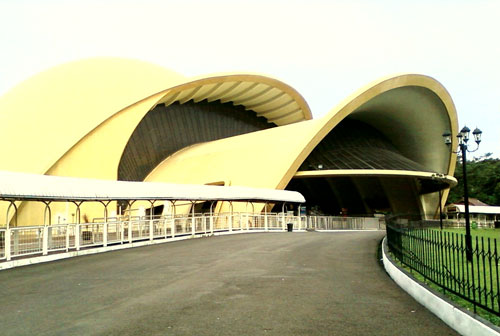 Keong Emas means Golden Snail. This theater is easily recognized
because the roof takes the shape a golden snail. Located in the Taman
Mini, the Imax Theater presents "Beautiful Indonesia" on a gigantic
screen using the latest Imax system. The theater was first open to the
public on April 20, 1984 and it's enormous screen, using the latest Imax
System, has been listed in the Guinness Book of Records as the largest
screen in the world during the 1985, 1986, 1987, 1988, 1989, 1990 and
1991 edition. This theater is located in East Jakarta, in the complex
area of Taman Mini Indonesia Indah (The Miniature of Indonesia Park),
which was also built on the initiative of Madame Tien Suharto.
Keong Emas means Golden Snail. This theater is easily recognized
because the roof takes the shape a golden snail. Located in the Taman
Mini, the Imax Theater presents "Beautiful Indonesia" on a gigantic
screen using the latest Imax system. The theater was first open to the
public on April 20, 1984 and it's enormous screen, using the latest Imax
System, has been listed in the Guinness Book of Records as the largest
screen in the world during the 1985, 1986, 1987, 1988, 1989, 1990 and
1991 edition. This theater is located in East Jakarta, in the complex
area of Taman Mini Indonesia Indah (The Miniature of Indonesia Park),
which was also built on the initiative of Madame Tien Suharto.The Keong Emas Imax Theater has become one of the most popular attractions where lots of tourists, domestic and foreign, young and adult, especially groups of children visit. Besides the large dimension of the screen, the theater also has another feature that makes it attractive: the films are displayed in three dimensions (3D). The subjects of the movies on display are mainly "Beautiful Indonesia" related to its culture and art, as well as its environment and the places around Indonesia. All in all, the main purpose of the movies is to highlight Indonesia's beauty on the big screen and attract tourism. This location is open from 11.00 am - 5.00 pm.
Jaya Ancol Dreamland (Taman Impian Jaya Ancol)
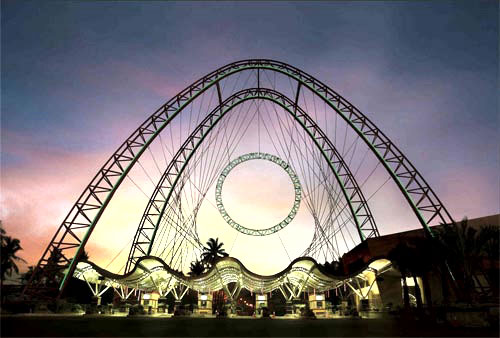 Taman Impian Jaya Ancol, an amusement park in north Jakarta,
Indonesia, is one of the most attractive places serving the densely
populated city of Jakarta. It has all the adventures people crave for;
Sea World, Fantasy World, Atlantis Water Adventure and Marina Beach.
This is Jakarta's largest and most popular recreation park. It is built
on reclaimed beach land at the Bay of Jakarta, having, sea and
freshwater aquariums, swimming pools, an artificial lagoon for fishing,
boating, bowling, an assortment of nightclubs, restaurants, a steam-bath
and massage parlors. The Ancol complex includes a Marina, Dunia Fantasi
(Fantasy Land), a golf course, hotels and a drive-in theater. The
"Pasar Seni" or art market has a varied collection of Indonesian
handicraft, paintings and souvenirs on sale. At a nearby open-air
theater art performances are held using the local dialect.
Taman Impian Jaya Ancol, an amusement park in north Jakarta,
Indonesia, is one of the most attractive places serving the densely
populated city of Jakarta. It has all the adventures people crave for;
Sea World, Fantasy World, Atlantis Water Adventure and Marina Beach.
This is Jakarta's largest and most popular recreation park. It is built
on reclaimed beach land at the Bay of Jakarta, having, sea and
freshwater aquariums, swimming pools, an artificial lagoon for fishing,
boating, bowling, an assortment of nightclubs, restaurants, a steam-bath
and massage parlors. The Ancol complex includes a Marina, Dunia Fantasi
(Fantasy Land), a golf course, hotels and a drive-in theater. The
"Pasar Seni" or art market has a varied collection of Indonesian
handicraft, paintings and souvenirs on sale. At a nearby open-air
theater art performances are held using the local dialect.Inside the Ancol Dreamland, there is Ancol Art Market, it is outdoor art market likely recreational place where we will be most tempted to purchase something. Items include antiques, handicrafts, painting, potters, and knickknacks. With many of the artisans working on site, it is a paradise for souvenir hunters and art lovers. This colorful open-air market located in the Ancol Amusement Park provides the unique experience of not only buying quality Indonesian arts and craft, but also a chance to see and meet the artisans at work. We can watch puppet makers, wood-carvers, painters, and many other craft makers from throughout the archipelago cheerfully working on their creations. At this art and handicraft market, visitors get to watch Indonesian artists creating their masterpieces. Hundreds of artists from all over the country congregate here to exhibit their work, making the spot a fascinating place for tourists and art connoisseurs. We can even get a portrait of our self-done. Both traditional and modern art and crafts are on display, including paintings, sculptures, traditional Indonesian wayang kulit (leather puppets), gemstone jewelry and many other artistic products. Art performances are frequently held at the Art Market (Pasar Seni) inside the Jaya Ancol Dreamland on Jakarta's beach. They normally range from wayang kulit shadow plays to folk dances and modern drama. This location is open Monday to Saturday, from 2 p.m. to 9 p.m.; Sunday, from 10 a.m. to 9 p.m.
Sea World
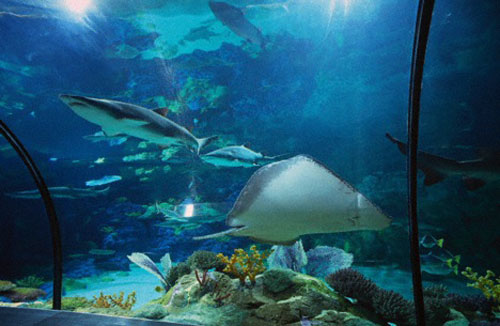 Inside the Ancol Dreamland complex, Sea World is a high tech
modern huge aquarium exhibiting the special and diverse tropical marine
life found throughout the Indonesian waters. Stroll through Freshwater
World and Micro world, see beautiful tropical fish and corral reefs, and
get friendly with marine life at the Touch pool. A theater screens
movies about the underwater world and a necessity is the Antasena
Tunnel, a walk-through acrylic tube that gives first hand experience of
life under the sea. This giant aquarium proudly introduces visitors to
more than 4,000 fish and sharks from 300 species. Sea World has great
many attractions to its credit; it has a Dolphin Show that is quite
popular and a gallery, which showcases many of sea creatures from all
over the world. Some times people find it better in comparison to
Sentosa Island, one of the most popular destinations in Singapore.
Inside the Ancol Dreamland complex, Sea World is a high tech
modern huge aquarium exhibiting the special and diverse tropical marine
life found throughout the Indonesian waters. Stroll through Freshwater
World and Micro world, see beautiful tropical fish and corral reefs, and
get friendly with marine life at the Touch pool. A theater screens
movies about the underwater world and a necessity is the Antasena
Tunnel, a walk-through acrylic tube that gives first hand experience of
life under the sea. This giant aquarium proudly introduces visitors to
more than 4,000 fish and sharks from 300 species. Sea World has great
many attractions to its credit; it has a Dolphin Show that is quite
popular and a gallery, which showcases many of sea creatures from all
over the world. Some times people find it better in comparison to
Sentosa Island, one of the most popular destinations in Singapore.Come and enjoy the deep-sea panorama while strolling through an 80-meter tunnel. The fascinating creatures live in some 500 million liters of seawater and are fed three times a day (some hand-fed). The attraction also features a theater, which plays three educational films in English and Bahasa Indonesia. Open Monday to Saturday, from 2 p.m. to 9 p.m.; Sunday, from 10 a.m. to 9 p.m.
Marina Jaya Ancol
 This is the port to reach Pulau Seribu (Thousand Islands) in the
Bay of Jakarta, as well as the center for marine sports ad recreation.
This is a special port for yachts, motor and sailboats, and the
scattered islands in the Bay of Jakarta. This is also the place for
marine recreation and sports where each facility is amply provided;
water cycles, canoes, sail boats, fishing gear and many others. Stalls
along the beach serve drinks and snacks while tents are available for
sunbathers and sea lovers.
This is the port to reach Pulau Seribu (Thousand Islands) in the
Bay of Jakarta, as well as the center for marine sports ad recreation.
This is a special port for yachts, motor and sailboats, and the
scattered islands in the Bay of Jakarta. This is also the place for
marine recreation and sports where each facility is amply provided;
water cycles, canoes, sail boats, fishing gear and many others. Stalls
along the beach serve drinks and snacks while tents are available for
sunbathers and sea lovers.Ancol Marina is the most usual departure point, speed boats leaving regularly to whisk us away from the city heat to the cool, palm fringed beaches of paradise. However chartering a boat is also possible for anyone with a more adventurous spirit. Jet skies canoes, sail boats wind surfing and waterskiing are all to be found, along with all kinds of fishing gear we may need for hire. Numerous stalls along the beach serve drinks and snacks while tents are available for sunbathers and sea-lovers.
Pelangi Island, a small island that located about 70 kilometers from Marina Ancol or about one and a half hours by speedboat, is a near Sepa Island and Pantara Island. The similarities of these beautiful islands are that they have sandy beaches and sit in the middle of a clean blue ocean. Pelangi Island had thronged by Italian and Japanese tourists. Presently, thanks to the domestic tourists and expatriates, the island economy is sustained.
T.I.M (Taman Ismail Marzuki) Art Center
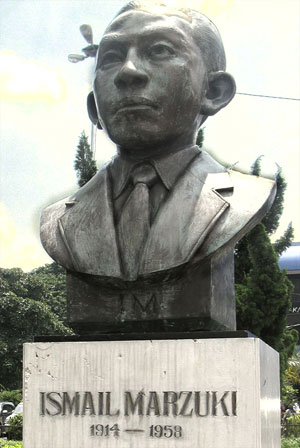 Jakarta is overflowing with hip clubs and bars catering to all
tastes. But if we want a snapshot of Jakarta's current artistic pulse
head to Taman Ismail Marzuki in Cikini. The center of Arts in Jakarta,
Taman Ismail Marzuki, also known as TIM, is a complex located on Cikini
Raya Street 37, Jakarta. Those who are looking for traditional and
contemporary arts might find this place useful. This complex acquired
its name from the great Indonesian musician, Ismail Marzuki, whose
statue guards the entrance gate. It hosts the Institut Kesenian Jakarta
(Jakarta Institute for the Arts) and Jakarta Platenarium. The arts
institute is the only one of its kind in Indonesia and the first local
college entirely dedicated to the training of performing and visual
arts. There are modern, state-of-the-art theatres and cinemas, more
traditional auditoriums, street performers and a cornucopia of
restaurants and bars offering basic but tasty food and drink from all
over Indonesia. The patrons range from the young, trendy,
keen-to-be-seen set to bohemian artistes debating the latest trends.
Jakarta is overflowing with hip clubs and bars catering to all
tastes. But if we want a snapshot of Jakarta's current artistic pulse
head to Taman Ismail Marzuki in Cikini. The center of Arts in Jakarta,
Taman Ismail Marzuki, also known as TIM, is a complex located on Cikini
Raya Street 37, Jakarta. Those who are looking for traditional and
contemporary arts might find this place useful. This complex acquired
its name from the great Indonesian musician, Ismail Marzuki, whose
statue guards the entrance gate. It hosts the Institut Kesenian Jakarta
(Jakarta Institute for the Arts) and Jakarta Platenarium. The arts
institute is the only one of its kind in Indonesia and the first local
college entirely dedicated to the training of performing and visual
arts. There are modern, state-of-the-art theatres and cinemas, more
traditional auditoriums, street performers and a cornucopia of
restaurants and bars offering basic but tasty food and drink from all
over Indonesia. The patrons range from the young, trendy,
keen-to-be-seen set to bohemian artistes debating the latest trends.The focal point of cultural activities in Jakarta is the Jakarta Art Center, known as Taman Ismail Marzuki or TIM in short. It is said to be the largest of its kind in Southeast Asia and consists of exhibition halls, theaters, an academy of arts, an archives building and a planetarium. A monthly programmed of events, available at hotel counters, includes exhibitions, plays, musical and poetry recitals, dance performances, folk art and drama from the various regions of Indonesia. Facilities include an indoor and outdoor theater, exhibition halls, two art galleries and a cineplex.
Pulau Seribu (Thousand Island)
 Thousand Isles near Jakarta has been a favorite destination for
ages. Paradiso, containing four island's Kahyangan (formerly known as
Cipir), Bidadari (used to be called Sakit), Onrust and Kelor offer
spectacular views of the forest and the sea. The name Paradiso indeed
comes from Paradise, for 'Kahyangan' in Indonesian means 'Heaven' in
English, and 'Bidadari' means 'Angel'. Dotted throughout Jakarta Bay are
120 tropical islands and coral atolls known, rather misleadingly, as
the Thousand Islands. This group of islands in the Jakarta Bay offers a
heaven away from the bustle of city life. There are golden beaches
fringed with coconut palms. The surrounding waters are a paradise for
skin divers. They are filled with a myriad of tropical fish, which live
among the multicolored corals. The islands can be reached from Tanjung
Priok or Pasar Ikan (Sunda Kelapa) by ferry or by chartered boat. Some
of the islands in this group developed for tourism are Pulau Bidadari,
Pulau Anyer, Pulau Laki and Pulau Putri. Pulau Tanjung near Putri has an
airstrip. There are cabins for hire, having fresh water on Pulau Air
and Pulau Bidadari only. The Pulau Putri Paradise Co. has developed
Pulau Putri, Pulau Melintang, Pulau Petondan and Pulau Papa Theo as a
holiday resort with cottages, restaurants, diving and sailing
facilities. With a total population of only 13,000 people, the bay
contains a sprinkling of the 'virgin islands', although the majorities
are inhabited. Many are privately owned. The departure point to this
cluster of individual paradises is the Ancol Marina, where further
information on travel arrangements can be found. Daliy boats to most
islands, departing at 08.00 and 09.00.
Thousand Isles near Jakarta has been a favorite destination for
ages. Paradiso, containing four island's Kahyangan (formerly known as
Cipir), Bidadari (used to be called Sakit), Onrust and Kelor offer
spectacular views of the forest and the sea. The name Paradiso indeed
comes from Paradise, for 'Kahyangan' in Indonesian means 'Heaven' in
English, and 'Bidadari' means 'Angel'. Dotted throughout Jakarta Bay are
120 tropical islands and coral atolls known, rather misleadingly, as
the Thousand Islands. This group of islands in the Jakarta Bay offers a
heaven away from the bustle of city life. There are golden beaches
fringed with coconut palms. The surrounding waters are a paradise for
skin divers. They are filled with a myriad of tropical fish, which live
among the multicolored corals. The islands can be reached from Tanjung
Priok or Pasar Ikan (Sunda Kelapa) by ferry or by chartered boat. Some
of the islands in this group developed for tourism are Pulau Bidadari,
Pulau Anyer, Pulau Laki and Pulau Putri. Pulau Tanjung near Putri has an
airstrip. There are cabins for hire, having fresh water on Pulau Air
and Pulau Bidadari only. The Pulau Putri Paradise Co. has developed
Pulau Putri, Pulau Melintang, Pulau Petondan and Pulau Papa Theo as a
holiday resort with cottages, restaurants, diving and sailing
facilities. With a total population of only 13,000 people, the bay
contains a sprinkling of the 'virgin islands', although the majorities
are inhabited. Many are privately owned. The departure point to this
cluster of individual paradises is the Ancol Marina, where further
information on travel arrangements can be found. Daliy boats to most
islands, departing at 08.00 and 09.00.This chain of several dozen islets immediately north of the city is administratively part of Jakarta and usually an oasis of quiet. Speedboats take visitors to basic but comfortable hotels an hour or so from the city, where one can snorkel, dive or just lie on a white sand beach with a friendly turtle.
Ragunan Zoo
 Ragunan zoo in South Jakarta is a popular place to visit,
particularly during holidays. Jakarta's zoo is situated in the suburb of
Ragunan in the southern part of the city. Laid out in a lush tropical
setting, such indigenous animals as the Komodo lizard, tapir, anoa, Java
tiger, banteng, wild ox and brightly colored birds are given ample room
to be in this green foliage. The new primates are centered at Ragunan
Zoo. It's a world-class facility and guaranteed to entertain and educate
both the young and young at heart.
Ragunan zoo in South Jakarta is a popular place to visit,
particularly during holidays. Jakarta's zoo is situated in the suburb of
Ragunan in the southern part of the city. Laid out in a lush tropical
setting, such indigenous animals as the Komodo lizard, tapir, anoa, Java
tiger, banteng, wild ox and brightly colored birds are given ample room
to be in this green foliage. The new primates are centered at Ragunan
Zoo. It's a world-class facility and guaranteed to entertain and educate
both the young and young at heart.According to its history, Taman Margasatwa Ragunan, or Ragunan Wildlife Reserve, was first set up by a Dutch flora and fauna lovers organization. The organization, the Vereneging Plantenen Dierentuin at Batavia, set up the park on a 10-hectare plot of land in Cikini Raya Street 2, South Jakarta in 1864. The park, Plantenen Dierentuin, was moved to the present location in 1964 to accommodate the city's development plan. In the new location, the park was given a 10-hectare plot of land, but now it occupies 135 hectares of land. This zoo was located at Cikini until 1964, when the site was no longer large enough to accommodate its rapid expansion. Reopened in 1966, the zoo now exhibits 550 species of tropical plants and animals from Indonesia and around the world. Endangered species bred here include the Sumatran tiger, Komodo dragon, dwarf buffalo and bird of paradise.
Now, the zoo is busy preparing a 10-hectare enclosure, which was described by the director as the largest and most luxurious one in the world, for the new guests. The spot is ideal for family excursions and picnics amid the abundant flora. Come during weekdays when it is less crowded. Open dally from 8.00 a.m. to 6.00 p.m. The zoological garden is most crowded on Sunday and public holidays.
National Museum
 The Museum is situated on Merdeka Barat Street. Currently the
National Museum houses collections of 109,342 objects under the
categories of prehistory, archaeology, ethnography,
numismatics-heraldic, geography and historical relics. In 1994, the
museum started with is expansion project. The new building, constructed
in the same architectural style as the old, comprises an arena for
theatrical performances and more spaces for exhibitions. The museum
curators provide detailed information and guidance on
collections-related subjects during working hours. The daily activities
at the National Museum include collecting, caring for and protecting
collections and providing information on the museum and its collections
to visitors and the public at large. The Indonesian Heritage Society
(HIS) voluntarily assists the museum in handling the inventory of the
collections.
The Museum is situated on Merdeka Barat Street. Currently the
National Museum houses collections of 109,342 objects under the
categories of prehistory, archaeology, ethnography,
numismatics-heraldic, geography and historical relics. In 1994, the
museum started with is expansion project. The new building, constructed
in the same architectural style as the old, comprises an arena for
theatrical performances and more spaces for exhibitions. The museum
curators provide detailed information and guidance on
collections-related subjects during working hours. The daily activities
at the National Museum include collecting, caring for and protecting
collections and providing information on the museum and its collections
to visitors and the public at large. The Indonesian Heritage Society
(HIS) voluntarily assists the museum in handling the inventory of the
collections.The museum's Conservation and Restoration Division is dedicated to conserving and restoring the collected objects in order to protect them from possible damages and loss. The staffs also take preventive measures against possible damages or loss through manual, alarm and control system. This Museum is open from 8.30 am to 2.30 pm on Tuesday, Wednesday, Thursday and Sunday, from 8.30 am to 11.30 am on Friday, and from 8.30 am to 1.30 pm on Saturday. The Museum is closed on Monday and Public Holidays.
This museum is also has supporting with such tourism facilities. A small gift shop located in the entrance hall has the same opening hours as the rest of The Museum. It offers a selection of books, postcards and reproductions of various exhibits. The front courtyard can accommodate cars and tour buses. Visitors are kindly asked to refrain from smoking, eating and drinking in all areas of the Museum, and are prohibited from touching the exhibits.
Jakarta History Museum
 Located in the historic Old Jakarta Kota area, Taman Fatahillah
square offers three of the city's most interesting museums. Once the
heart of the colonial administration in the 18th century the square
underwent a major restoration in the 1970's. A fountain in the middle of
square once as the main water supply for the former colonial capital.
The Portuguese cannon on the north side of the square is reportedly an
impressive font of fertility. Jakarta History Museum is the one
displaying the history of the development of the City of Jakarta, both
the events and the community, from the prehistory until these present
days. This museum is located in a building of cultural property which in
the past known as Stadhuis, the City Hall of Batavia. As written on an
inscription of the Museum collection, the building was constructed in
1707 by the city government of Batavia during the period of VOC and
Governor General Abraham van Riebeeck inaugurated it in 1710. This
building is located in front of a park, which in the past was known as
Stadhuisplein, the City Hall Park, and now it is called Taman
Fatahillah.
Located in the historic Old Jakarta Kota area, Taman Fatahillah
square offers three of the city's most interesting museums. Once the
heart of the colonial administration in the 18th century the square
underwent a major restoration in the 1970's. A fountain in the middle of
square once as the main water supply for the former colonial capital.
The Portuguese cannon on the north side of the square is reportedly an
impressive font of fertility. Jakarta History Museum is the one
displaying the history of the development of the City of Jakarta, both
the events and the community, from the prehistory until these present
days. This museum is located in a building of cultural property which in
the past known as Stadhuis, the City Hall of Batavia. As written on an
inscription of the Museum collection, the building was constructed in
1707 by the city government of Batavia during the period of VOC and
Governor General Abraham van Riebeeck inaugurated it in 1710. This
building is located in front of a park, which in the past was known as
Stadhuisplein, the City Hall Park, and now it is called Taman
Fatahillah.Since 1970, the surroundings of Taman Fatahillah have been declared as Cultural Property and it was totally preserved. This effort was the beginning of the development of the historical area of the City of Jakarta, carried out by the Government of DKI Jakarta. The Museum of History of Jakarta was inaugurated on 30 March 1974 for being the center for collection, conservation and research for all kinds of objects of cultural property related to the history of the City of Jakarta and at the same time becomes a center for education, study and recreation for the community. Due the very long course of the history of Jakarta, the collection of this Museum are highly varied in shape and consist of objects being the heritage of the prehistorical period until the beginning of the 20th century. There are another replicas of the Tugu Inscription from the age of Great King Purnawarman, forming evidence that the center of the Kingdom of Tarumanegara was located in around the seaport of Tanjung Priok. Further, a map of the 16th century and the replica of the Padrao monument of the Portuguese represent the historical evidence of the age of Sunda Kelapa Harbor. The period of Jayakarta is the beginning of the establishment of the City bronze cannon and through various drawings and maps of the 17th century. Furniture collection of Betawi style from the 17th, 18th and 19th century is the richest collection and belongs to the most complete one in the world. This collection is very interesting since the association reflects of the community of Batavia City with various cultural elements from Europe, especially Dutch, China, India and Indonesia.
Shadow Puppets Museum
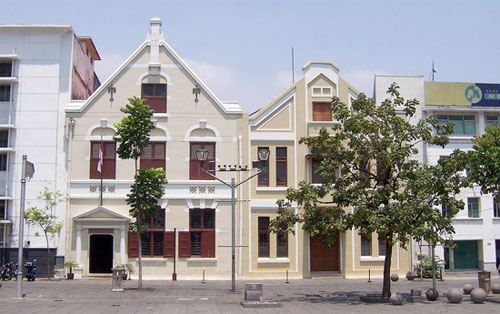 This artistic building stay at Pintu Besar Utara Street 27, West
Jakarta, was built in 1912, previously as land of a church, which was
built in 1640 under the name of De Oude Hollandsche Kerk (The Old Dutch
Church). In 1732 it was renovated and its name was changed into De
Nieuwe Hollandsche Kerk (The New Dutch Church). The church building was
once totally destroyed by an earthquake. Bataviasche Genootschap van
Kunsten en Wetenschappen (Batavia Society of Arts and Sciences), that
was an institution dealing with science and Indonesian culture bought
this building.
This artistic building stay at Pintu Besar Utara Street 27, West
Jakarta, was built in 1912, previously as land of a church, which was
built in 1640 under the name of De Oude Hollandsche Kerk (The Old Dutch
Church). In 1732 it was renovated and its name was changed into De
Nieuwe Hollandsche Kerk (The New Dutch Church). The church building was
once totally destroyed by an earthquake. Bataviasche Genootschap van
Kunsten en Wetenschappen (Batavia Society of Arts and Sciences), that
was an institution dealing with science and Indonesian culture bought
this building.The institution then delivered this building to the Stichting Oud Batavia (Old Batavia Foundation) and on 22 December 1939. It was made a museum under the name of Oude Bataviasche Museum (Old Batavia Museum). In 1957 this building was delivered to Lembaga Kebudayaan Indonesia (Institute of Indonesian Culture) and on 17 September 1962 it was delivered to the Ministry of Education and Culture of the Republic of Indonesia, which later was delivered to the DKI Jakarta Administration on 23 June 1968 to be made Shadow Puppet Museum, which inauguration was carried out on 13 August 1975.
Shadow Puppet (commonly known as wayang) in Indonesia, especially on Java Island, was originally a product of the Royal Court culture. It was first used as an instrument of worship to the ancestors, and after the Hindu culture entered Indonesia iaround the 5th century, it developed shifting of values. The world of Indonesian shadow puppet got characteristically influence especially in term of story, like the Ramayana (the Story of Rama) and Mahabharata (the Great Bharata), making the form of presentation keep on changing and with wider range in performance and in the theme of the story. In its later development the Indonesian shadow puppet had become such tradition, that it has been capable to hold out in the supporting community consisting of various elements. Visitors of this Museum are invited to know various characters, attitude and behavior of the story from various regions through the performance of shadow puppet that has weight of high value in our culture and viewing a number of collections of shadow puppet like wayang kulit, wayang golek, patung wayang, topeng wayang, wayang beber, wayang kaca, gamelan (traditional music instrument set) as well as wayang paintings.
This Museum also displays various collections of wayang and dolls from friendly countries like Malaysia, Thailand, Suriname, China, Vietnam, France, India and Cambodia. It is not merely to be an object for recreation, study for students/ devotee can be carried out in this Museum, and this Museum even can be used as venue for training, documentation center and research on shadow puppet, and it can be used as inter-regional and international media on cultural knowledge. To support its existence, in this Museum wayang staging and attraction of wayang making are periodically organized.
1945 Struggle for Freedom Museum
 1945 Struggle for Freedom Museum is located at Menteng Raya
Street 31, Central Jakarta. In 1938, a Dutch businessman named LC
Schomper, built a hotel called Schomper, I at Menteng Area. The hotel
was built as a place to spend nights for high officials of the
Nederland, foreign Entrepreneurs, and high officials of local
government.
1945 Struggle for Freedom Museum is located at Menteng Raya
Street 31, Central Jakarta. In 1938, a Dutch businessman named LC
Schomper, built a hotel called Schomper, I at Menteng Area. The hotel
was built as a place to spend nights for high officials of the
Nederland, foreign Entrepreneurs, and high officials of local
government.During the colonization of the Japanese Empire in Indonesia youth and it was turned into a boarding house and Education center for Indonesian Youth in order to learn nationalism. Soekarno (1st Indonesian President), Mohammad Hatta (1st Indonesian Vice President), Adam Malik Chaerul Saleh and many other youth generations of Indonesia are involved in the educations process inside. The name of the Hotel Schomper 1 Hotel then turned into Gedung Menteng 31 Building). As time went by, the Gedung Menteng 31 was used for many purposes. It was once used as office of Ministry of Manpower arrangement, National Boards of the Generation of 1945, and Jointly Secretariat of Nation Works Organization (secretariat Bersama Golongan Karya) - Embrio the GOLKAR Party.
After the building was renovated and repaired Gedung Menteng 31 was officially established as Museum Joang 45 on August 19, 1974, by former President Soeharto and former governor of Jakarta Ali Sadikin. The name, Museum Joang 45' is chosen as the building has played great role on the Independence if Indonesia and could become a site for the inheritance process of invaluable struggle values in 1945. The Museum is open from 8.00 am to 3.00 pm on Monday to Friday.
Tidak ada komentar:
Posting Komentar